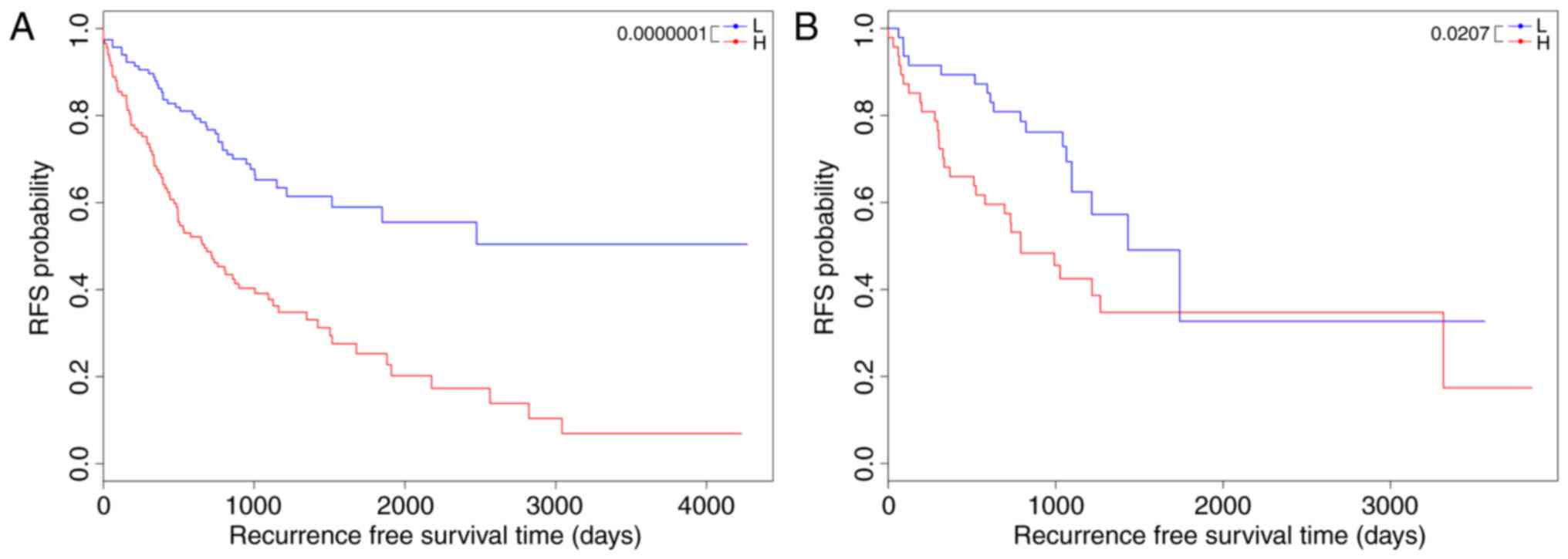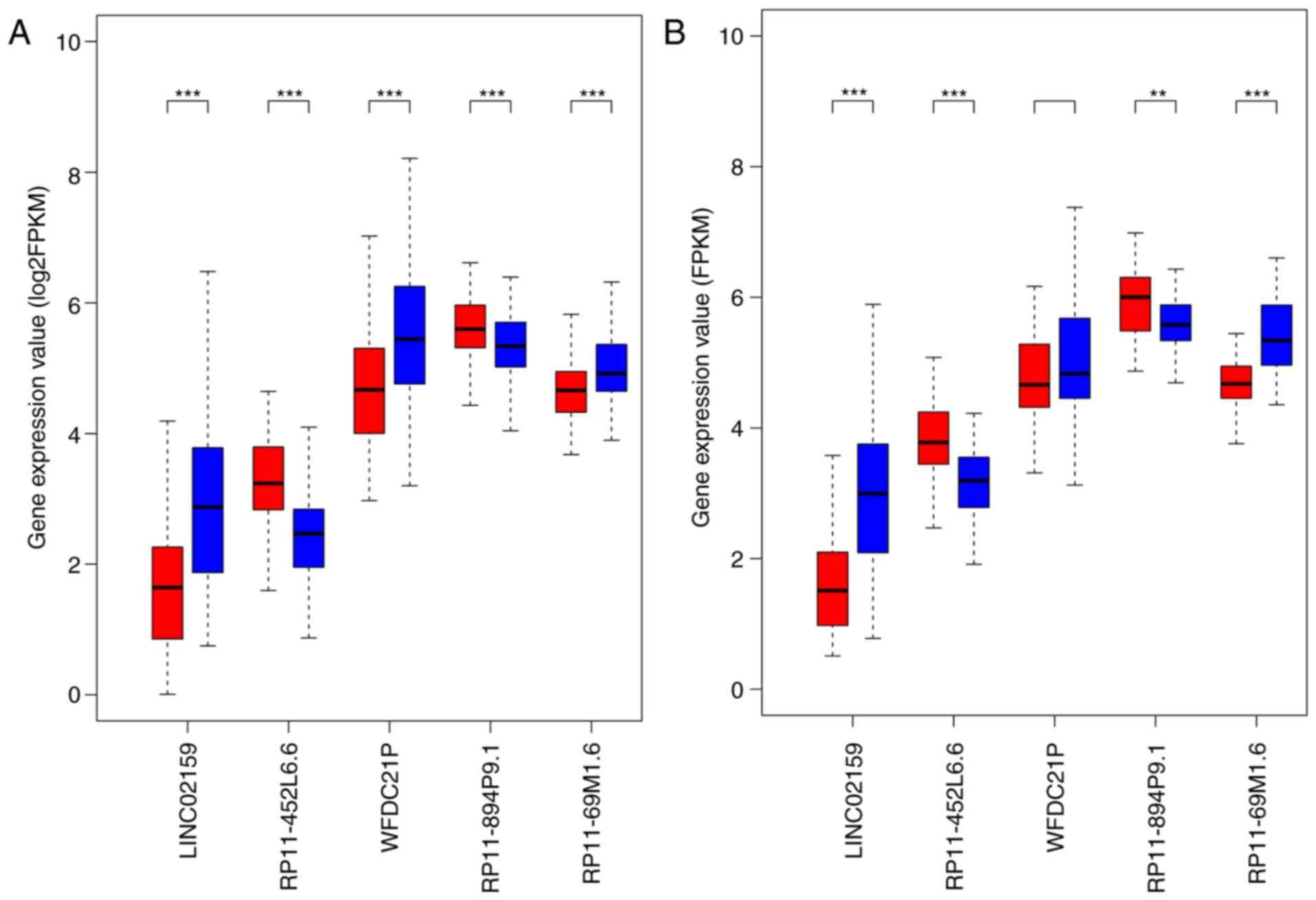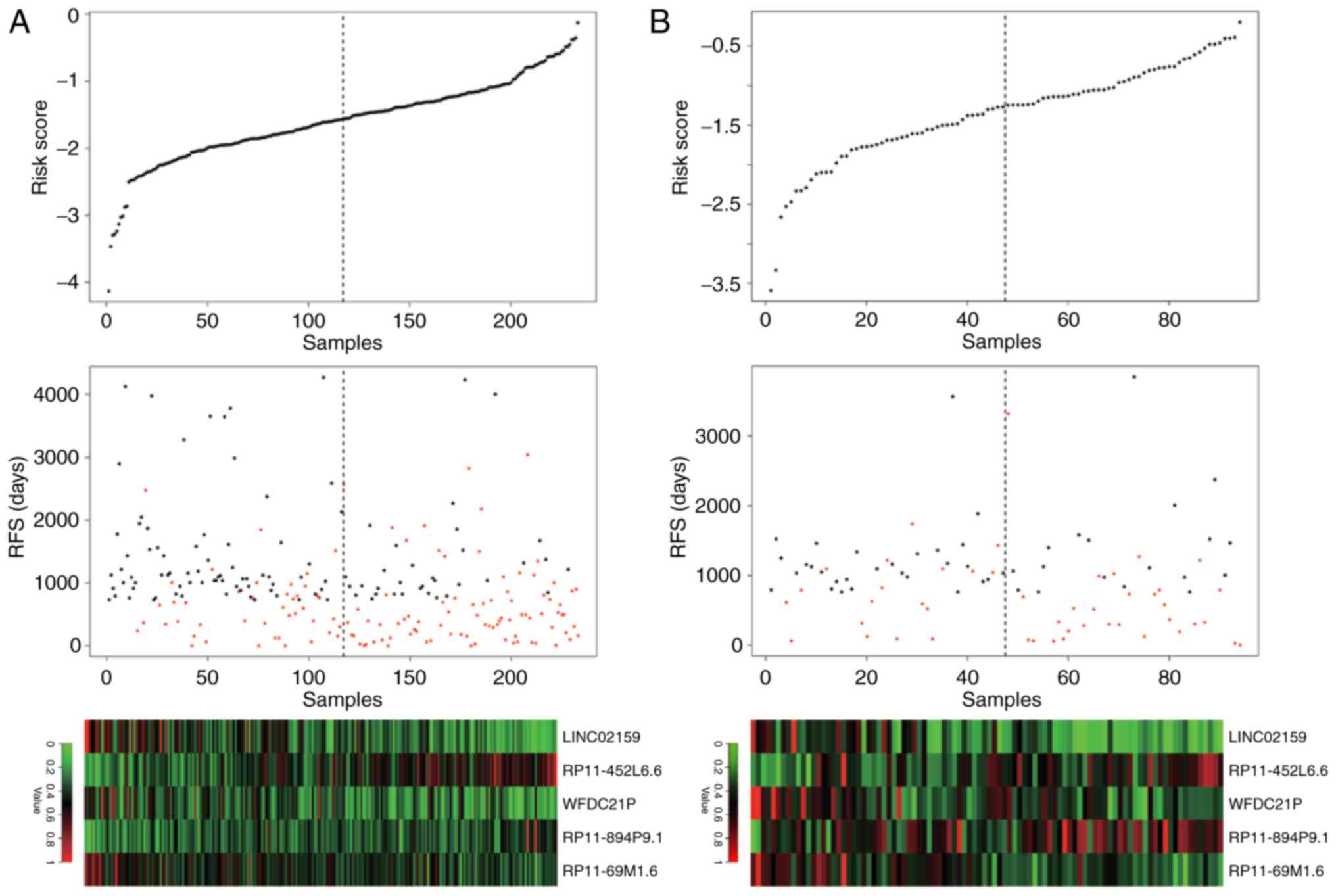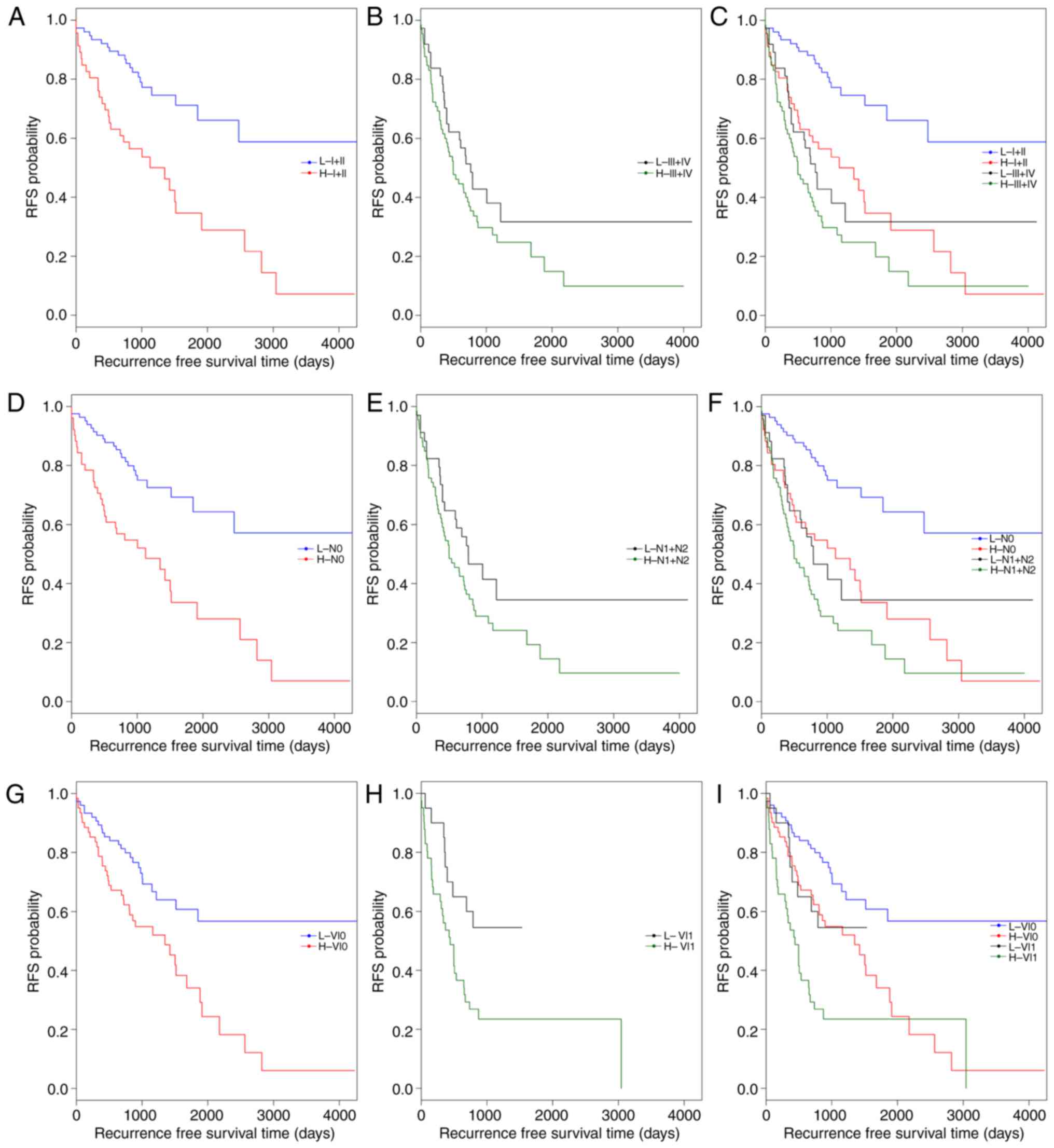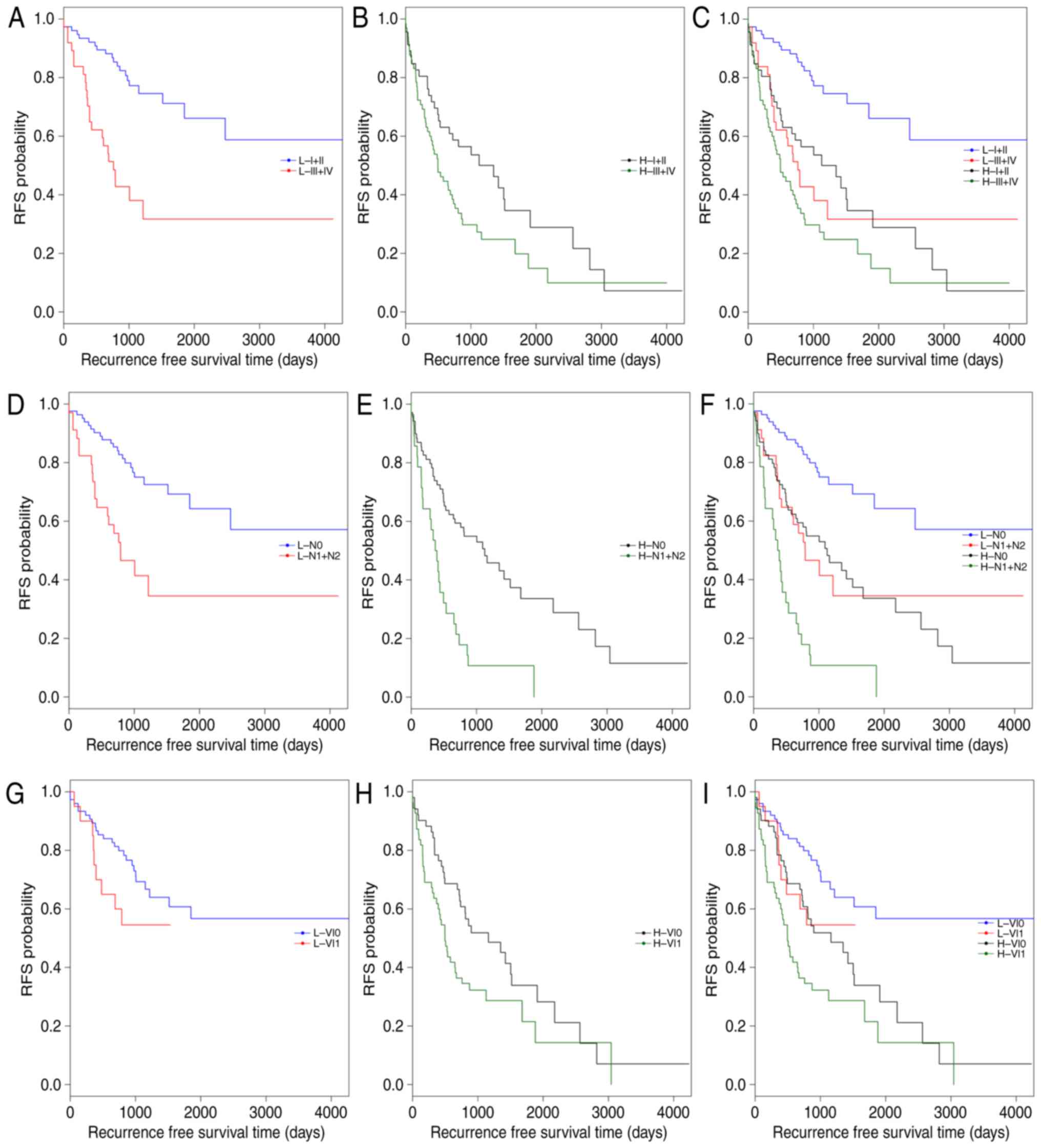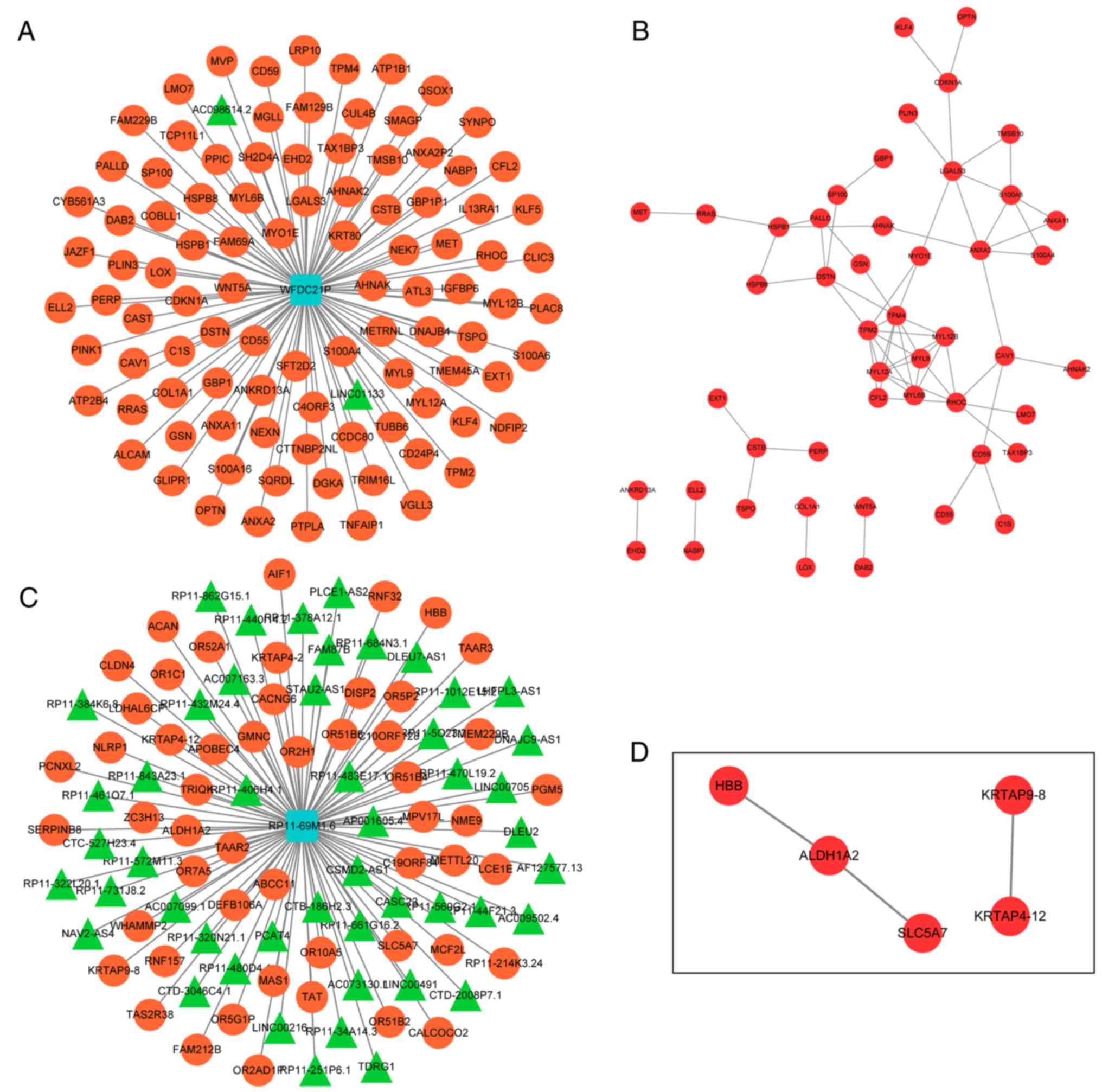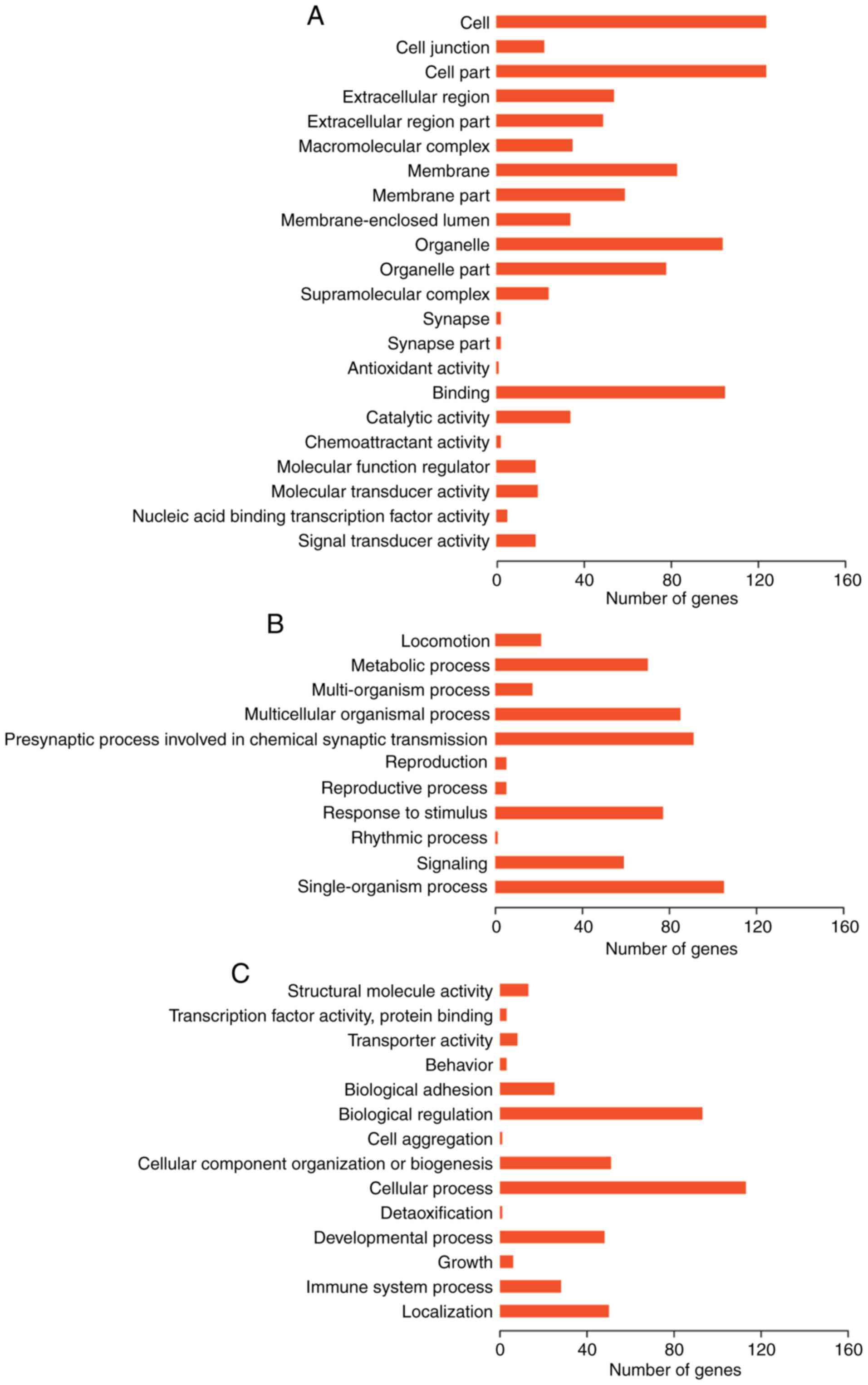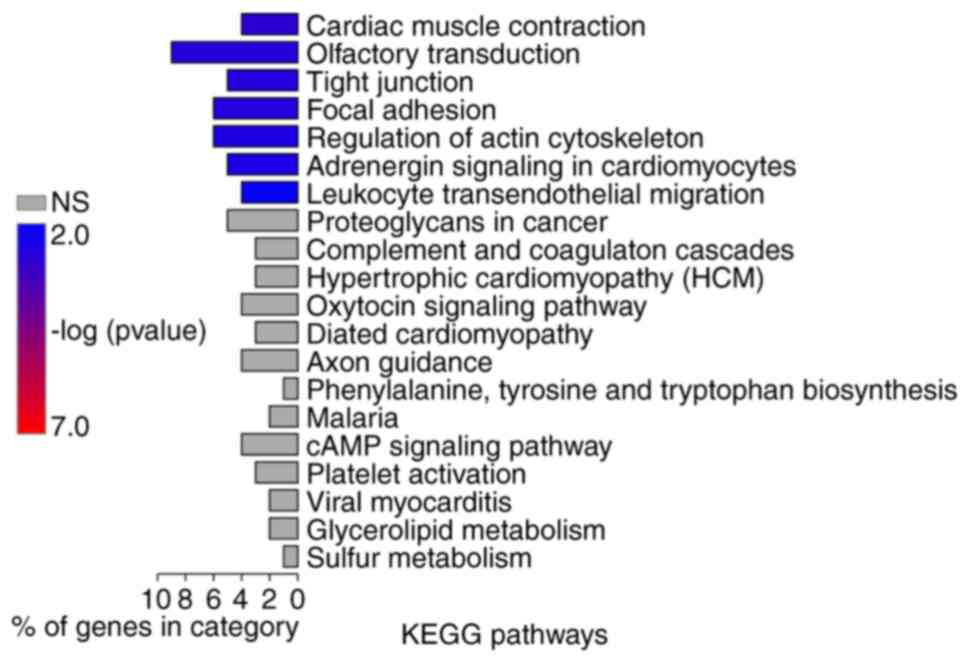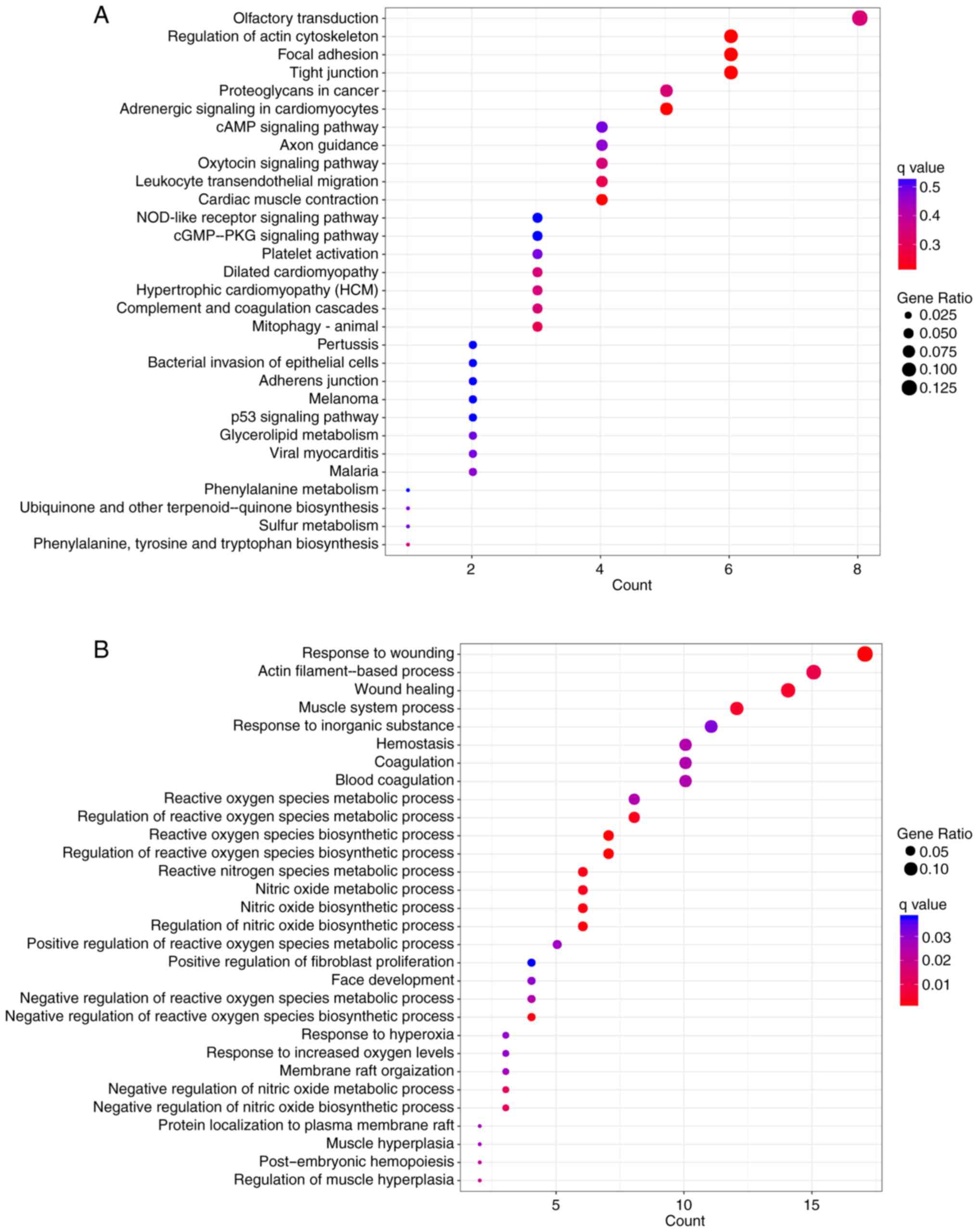Identification of a 5‑lncRNA signature‑based risk scoring system for survival prediction in colorectal cancer
- Authors:
- Published online on: May 3, 2018 https://doi.org/10.3892/mmr.2018.8963
- Pages: 279-291
-
Copyright: © Gu et al. This is an open access article distributed under the terms of Creative Commons Attribution License.
Abstract
Introduction
Colorectal cancer (CRC) is the third leading cause of cancer worldwide, with ~1.3 million new cases diagnosed every year (1). Surgery is a curative option for the majority of patients with early-stage CRC, whereas interventions are often aimed at improving quality of life and relieving symptoms of CRC at later stages. The 5-year survival rate of CRC varies from >90% in stage I cases to ~10% in stage IV cases (2). Recurrence and metastasis are two major reasons accounting for the poor outcome (3); therefore, promising molecular biomarker candidates to improve prognostic prediction and therapeutic outcome in CRC are required.
Long noncoding RNAs (lncRNAs), once considered transcriptional noise, have recently become an important field in research. LncRNAs are mRNA-like transcripts >200 nucleotides long, which do not encode proteins (4). Previous studies demonstrated that lncRNAs are involved in the tumorigenesis of numerous cancer phenotypes via interactions with DNA, RNA, protein and other cellular molecules (5,6). Expression of lncRNA metastasis-associated lung adenocarcinoma transcript 1 and prostate cancer-associated ncRNA transcripts 1 have been reported to be markedly elevated in CRC tissues compared with in paired normal tissues, and of prognostic significance in CRC (7,8). In addition, Qi et al (9) revealed that lncRNA LOC285194 expression is significantly reduced in CRC tissues, and is associated with poor disease-free survival. Recently, Ozawa et al (10) indicated that colon cancer-associated transcript 1 and 2 may be of strong prognostic value in CRC. These findings suggested the necessity to identify potential prognostic lncRNAs in CRC; however, there are few studies focusing on the identification of reliable prognostic lncRNAs in CRC.
In the present study, a systematic analysis of the lncRNA expression profiles in patients with CRC derived from The Cancer Genome Atlas (TCGA; https://gdc-portal.nci.nih.gov/) portal was initially conducted; differentially expressed lncRNAs (DELs) were screened between CRC patients with good and poor prognoses, from which, prognostic lncRNA signatures were identified using univariate and multivariate Cox regression analyses. Based on the expression of these signature lncRNAs, a risk scoring system was successfully developed and was employed to classify patients in a training set or an independent testing set into high-risk and low-risk groups. Furthermore, interactions between the co-expressed genes of these signature lncRNAs were analyzed in protein-protein interaction (PPI) networks, followed by functional analyses to determine their possible functional roles in CRC. The present study aimed to provide novel insight into the lncRNAs with promising prognostic value in CRC and to improve the survival of patients with CRC.
Materials and methods
Datasets
The present study was performed using an mRNA-seq dataset of colon adenocarcinoma samples retrieved from TCGA data portal, a publicly available repository. Samples with follow-ups of <2 years and without recurrence, or without recurrence-free survival (RFS) time information were excluded from the analysis; consequently, 233 remaining samples were defined as a training set. Additionally, the present study employed a TCGA rectal adenocarcinoma (READ) mRNA-seq dataset. Similarly, following the removal of samples with follow-ups of <2 years and without recurrence, or without RFS time record, 94 remaining samples in the READ set were included in the present study as a testing set. Clinical features of the training and the testing sets are presented in Table I.
GENCODE gene annotation (www.gencodegenes.org/) (11) is the largest publicly available catalogue of human lncRNAs. Genes in the training and testing sets were annotated by GENCODE (11). The resulting lncRNAs were used for further analysis.
Screening for prognosis-associated DELs
According to RFS time and cancer recurrence status, the 233 samples in the training set were classified into a good prognosis group (n=106), in which patients exhibited RFS time ≥2 years without cancer recurrence, and a poor prognosis group (n=127), in which patients experienced cancer recurrence. With an adjusted P-value (P<0.05) as a strict cutoff value, DELs between the two groups were screened using edgeR package (12–14) or DESeq2 package (15) (Bioconductor; www.bioconductor.org/) in R3.3.3 language.
Prognosis-associated DELs were identified from the overlapped DELs between the two packages using univariate Cox regression analysis (16) in survival package 2.41-3 (cran.r-project.org/web/packages/survival/index.html) in R 3.4.3, followed by log-rank test (cut-off value, P<0.01). Subsequently, these identified prognosis-associated DELs were subjected to multivariate Cox regression analysis.
Development of risk scoring system
Based on the expression of significant prognostic lncRNAs derived from multivariate Cox regression analysis, the risk score was calculated as the linear combination of expression levels of these lncRNAs, which were weighted by regression coefficients (16,17), and a risk scoring system was developed as follows:
Risk score = β1 × expr1 + β2 × expr2 + ··· + βn × exprn
Where βn stands for estimated regression coefficient of lncRNAn, and exprn stands for expression levels of lncRNAn.
The risk scoring system was used to divide patients in each set into high-risk and low-risk groups, with the median risk score of the set being the cut-off point. Kaplan-Meier survival analyses were employed to compare the RFS time of the high-risk and low-risk groups, followed by log-rank test. Furthermore, univariate and multivariate Cox regression analyses, and data stratification analysis (χ2) were conducted to evaluate whether the risk score was independent of clinical features. For these tests, P<0.05 was considered to indicate a statistically significant difference. In addition, the expression levels of these selected lncRNAs were compared between the high-risk group and the low-risk group using Student's t-test in the R stats package 3.4.3 (www.rdocumentation.org/packages/stats/versions/3.4.3) with a threshold of P<0.05.
Construction of lncRNA-gene networks and PPI networks
Co-expressed genes of these significant lncRNAs identified by multivariate Cox regression analysis were analyzed using the Multi-Experiment Matrix (MEM) web-based online tool (18,19) (http://biit.cs.ut.ee/mem/index.cgi) in Human Genome U133 Plus 2.0. These co-expressed genes were ranked according to a score of significance by the MEM tool. The top 100 genes of each lncRNA were selected for the construction of a lncRNA-gene network using Cytoscape 3.0 (20) (www.cytoscape.org/). In order to study the interactions between genes in each lncRNA-gene network, corresponding PPI networks were built using the Search Tool for the Retrieval of Interacting Genes (string-db.org/) (21) and visualized using Cytoscape 3.0 (20), with the threshold value set at median confidence=0.4.
Gene Ontology (GO) function and Kyoto Encyclopedia of Genes and Genomes (KEGG) pathway enrichment analyses
GOATOOLS 0.8.2 (github.com/tanghaibao/goatools) is an easily accessible Python package used for annotation of genes to biological processes (BP), molecular function (MF) and cellular component (CC) in the GO database. KOBAS 3.0 (kobas.cbi.pku.edu.cn/) is a web server used to annotate input genes and identify putative pathways involved, allowing for ID mapping and cross-species sequence similarity mapping (22). GO terms and KEGG pathways that may involve these genes in the lncRNA-gene networks were investigated with GOATOOLS and KOBAS, respectively. ClusterProfiler (Bioconductor; https://bioconductor.org/packages/release/bioc/html/clusterProfiler.html) is a R package used for the classification of biological terms and enrichment analysis of gene clusters, and is characterized by biological theme comparison among gene clusters (23). ClusterProfiler software 3.6.0 was applied to perform GO function and KEGG pathway enrichment analyses on the genes in the lncRNA-gene networks.
Results
Analysis of prognostic lncRNAs
Following removal of lncRNAs with 0 expression in at least 50 samples, there were a total of 4,162 lncRNAs in the training set. As a result, 82 DELs between good prognosis and poor prognosis samples were identified using the edgeR and DESeq2 packages. Among these resulting DELs, 44 were identified as prognosis-associated lncRNAs in univariate Cox regression analysis (P<0.01). Furthermore, as presented in Table II, 5 of the 44 prognosis-associated lncRNAs were detected to be independently associated with prognosis in multivariate Cox regression analysis, including ENSG00000253417 [long intergenic nonprotein coding RNA 2159, (LINC02159)], ENSG00000280132 (RP11-452L6.6), ENSG00000261040 [whey acidic protein four-disulfide core domain 21 (WFDC21P)], ENSG00000246451 (RP11-894P9.1) and ENSG00000279865 (RP11-69M1.6).
Development of a risk score system based on the 5-lncRNA signature
Based on the expression of the 5 lncRNAs derived from multivariate Cox regression analysis, a risk scoring system was developed as follows: Risk score = −0.219 × expr (LINC02159) + 0.354 × expr (RP11-452L6.6) −0.211 × expr (WFDC21P) + 0.143 × expr (RP11-894P9.1) −0.374 × expr (RP11-69M1.6)
The 5-lncRNA-based risk scoring system was applied to the training set to assort patients into high-risk and low-risk groups, with the median risk score as the threshold. In the training set, the low-risk group had a markedly longer RFS time compared with the high-risk group (38.547±29.693 months vs. 26.721±25.532 months, P=1×10−7; Fig. 1A). To validate the prognostic power of the risk scoring system in the testing set, all patients in the testing set were also classified into high-risk and low-risk groups by the risk scoring system. Similar results were yielded in the testing set (34.090±18.477 months vs. 29.305±26.450 months, P=0.0207; Fig. 1B).
Expression levels of the 5 prognostic lncRNAs in the training set and the testing set
Boxplots demonstrated that in the training set, the expression levels of LINC02159, WFDC21P and RP11-69M1.6 were significantly decreased, whereas the expression levels of RP11-452L6.6 and RP11-894P9.1 were significantly elevated in the high-risk samples compared with in the low-risk samples (P<0.001; Fig. 2A), which was validated in the testing set, except for WFDC21P (Fig. 2B). WFDC21P expression appeared to be reduced in the high-risk samples compared with in low-risk samples, but the difference was not significant. The distribution of risk score, RFS time and long noncoding RNA expression in the training set and the testing set were similar, indicating the robustness of the risk scoring system based on the 5 lncRNAs (Fig. 3).
Analysis on whether prognostic power of the 5-lncRNA signature-based risk score model is independent of clinical features
According to the results of a univariate Cox regression analysis, risk score, pathologic_stage, pathologic_M, pathologic_N, lymphatic_invasion and venous_invasion were demonstrated to be significantly associated with prognosis (Table III). Among these significant factors, risk score, pathologic_stage, pathologic_n and venous_invasion were identified to be independent predictors of prognosis according to the results of a multivariate Cox regression analysis (P<0.05; Table IV).
Subsequently, data stratification analysis was conducted for pathologic_stage, pathologic_n and venous_invasion (Fig. 4). All samples in the training set were stratified by pathologic_stage, pathologic_n and venous_invasion, respectively, into two groups. In each group, the 5-lncRNA based risk scoring model further split patients into a high-risk subgroup and a low-risk subgroup (Table V). Significantly different RFS time between high-risk and low-risk subgroups was observed in the pathologic_stage (I+II) group (P=4×10−5; Fig. 4A and C), the pathologic_n (N0) group (P=4×10−5; Fig. 4D and F), and patients with or without venous_invasion (P=0.0178 and P=0.001; Fig. 4G-I). However, the difference in RFS time between the high-risk and low-risk subgroups was not significant in the pathologic_stage (III+IV) group (P=0.1373; Fig. 4B) and the pathologic_n (N1+N2) group (P=0.0883; Fig. 4E). The results of multivariate Cox regression analysis and stratification analysis suggested that the risk classification power of the 5-lncRNA signature-based risk scoring system signature is independent of other clinical variables in CRC.
The present study also reported that the prognostic value of pathologic_stage, pathologic_n and venous_invasion were independent of risk score. For this, all patients in the training set were first classified into high- and low-risk groups by the risk scoring system. Each group was then stratified into two subgroups by pathologic_stage, pathologic_n or venous_invasion, respectively (Table VI). In both low-risk and high-risk groups, RFS time was significantly different between the patients at stage I+II and the patients at stage III+IV (low-risk: P=1×10−5; high-risk: P=0.0303, respectively; Fig. 5A-C). Similar results were observed between the patients with pathologic N0 and the patients with pathologic N1+N2 (low-risk: P=0.00026; high-risk: P=0.04216, respectively; Fig. 5D-F). As presented in Fig. 5G-I, the difference in RFS time between the patients with and without venous invasion was markedly significant in the high-risk group (P=0.0068), but was not significant in the low-risk group (P-value=0.1244). These observations confirmed that risk score, pathologic_stage, pathologic_n and venous_invasion are independent prognostic factors in CRC.
Analysis of co-expressed genes of prognostic lncRNAs
Since lncRNAs may serve their biological roles by regulating their co-expressed genes, co-expressed genes of the 5 lncRNAs were searched using the MEM tool. Only co-expressed genes of WFDC21P and RP11-69M1.6 were obtained. The top 100 co-expressed genes of WFDC21P or RP11-69M1.6 were used to construct lncRNA-gene networks. PPI networks were also generated to analyze the interactions between the genes in each lncRNA-gene network (Fig. 6).
Function analysis
GO function and KEGG pathway enrichment analyses were performed on genes in the two lncRNA-gene networks. GO enrichment analysis using GOATOOLS suggested that these genes were possibly associated with ‘cell membrane’, ‘organelle’ and other cellular components (Fig. 7). Pathway enrichment analysis conducted by KOBAS or ClusterProfiler revealed that these genes were significantly associated with numerous pathways, including ‘tight junction’, ‘focal adhesion’, ‘regulation of actin cytoskeleton’ and ‘leukocyte transendothelial migration’ (Figs. 8 and 9A). According to the results of GO enrichment analysis by ClusterProfiler, these genes were significantly associated with numerous GO BP terms, including ‘wound healing’, ‘reactive oxygen species (ROS) metabolism’ and ‘nitric oxide metabolism’ (Fig. 9B).
Discussion
CRC remains a major cause of mortality worldwide. Numerous lncRNAs have been reported to be involved in CRC tumorigenesis; however, there is a lack of efficient prognostic lncRNAs to refine the prediction of survival for patients with CRC (24). In order to define a prognostic lncRNA signature, the present study identified 82 DELs between CRC patients with good and poor prognoses in the training set. Among these DELs, WFDC21P, LINC02159, RP11-452L6.6, RP11-894P9.1 and RP11-69M1.6 were demonstrated to be significantly associated with prognosis via multivariate Cox regression analysis. Based on the expression of these 5 lncRNAs, a risk scoring system was generated. The results of the present study revealed that the 5-lncRNA signature-based risk scoring system may categorize patients into high- and low-risk groups with significantly varying RFS times in the training set and the testing set.
WFDC21P, namely lnc-dendritic cell (lnc-DC) has been observed to be exclusively expressed in human DCs and mediates the differentiation of monocytes to DCs via the activation of signal transducer and activator of transcription 3, which is a transcription factor that regulates numerous immune-associated genes (25,26). Wu et al (27) suggested that lnc-DC in plasma may be a possible biomarker for systemic lupus erythematosus. In addition, Zhang et al (28) reported that lnc-DC expression is increased in decidua, resulting in over-maturation of decidual DCs and increased T helper 1 cells in patients with preeclampsia. RP11-894P9.1 has been observed to be abnormally expressed in the right ventricle of the heart during heart failure (29); however, to the best of our knowledge, aberrant expression levels of WFDC21P and RP11-894P9.1 have previously not been reported in CRC. The functions of LINC02159, RP11-452L6.6, and RP11-69M1.6 remain unknown, and further investigations into lncRNA expression in cancer are required. The present study suggested that the 5-lncRNA signature may be a promising prognostic biomarker for CRC.
Previous studies have revealed the predictive value of T stage, venous invasion and lymph node metastasis in patients with CRC (30,31). Furthermore, in the present study, multivariate Cox regression analysis demonstrated that pathologic_stage, pathologic_n and venous_invasion were independently associated with prognosis. In addition, the results of data stratification analysis indicated that the prognostic value of the 5-lncRNA signature-based risk score may be independent of other clinical variables in CRC in the present study; therefore, the 5-lncRNA signature may aid in improving current prognostic approaches.
In order to uncover associated biological processes and signaling pathways of the 5-lncRNA signature, the present study attempted to identify the co-expressed genes of the 5 lncRNAs by MEM analysis. Only co-expressed genes of WFDC21P and RP11-69M1.6 were reported and lncRNA-gene networks were subsequently generated, followed by the construction of PPI networks to visualize the interactions between these genes. Furthermore, according to KEGG pathway enrichment analysis, these genes were significantly associated with ‘tight junction’, ‘focal adhesion’ and ‘regulation of actin cytoskeleton’ pathways. ‘Tight junction’ and ‘focal adhesion’ pathways are key determinants in tumor progression and metastasis (32,33). The ‘regulation of actin cytoskeleton’ pathway has been associated with cancer cell motility (34). Furthermore, the present study demonstrated that the genes in these lncRNA-gene networks were significantly associated with numerous GO BP terms that were associated with ‘ROS metabolism’ or ‘nitric oxide metabolism’. It has been established that abnormal ROS accumulation is a critical contributor to tumorigenesis (35). In addition, Colin et al (36) suggested that ROS may be involved in the development of resistance against resveratrol in colon cancer cells. Studies have also demonstrated that nitric oxide is an important regulator of tumor metabolism (37,38). These findings suggested that the 5-lncRNA signature may possibly be involved in ‘tight junction’, ‘focal adhesion’ and ‘regulation of actin cytoskeleton’ pathways, and ‘ROS metabolism’ and ‘nitric oxide metabolism’ in CRC by regulating the co-expressed genes.
Some limitations of the present study should be mentioned. Experiments were not conducted, and the size of the patient cohort may be further expanded. Therefore, future studies with larger patient cohorts are warranted to verify the prognostic significance of the 5-lncRNA signature prior to its use in clinical practice.
In conclusion, the present study identified a 5-lncRNA signature that may have great potential as a prognostic biomarker for CRC, and developed a 5-lncRNA signature-based risk scoring system as a prognostic classification system. Furthermore, the underlying signaling pathways and biological processes associated with the 5-lncRNA signature in CRC were investigated. These findings may aid in refining the stratification approach for the clinical assessment of prognosis, and provide guidance on tailored therapeutic strategies and patient management; however, further investigation is required to validate the findings of the present study.
Acknowledgements
The authors would like to thank Dr Min Yu for providing assistance in data collection and entry.
Funding
No funding was received.
Availability of data and materials
The datasets used and/or analyzed during the current study are available from the corresponding author on reasonable request.
Authors' contributions
LG wrote the manuscript. LG, JY, QW, BX, LY and LJ performed the data analyses. JY and LY revised the manuscript and provided important suggestions for the analyses. HC and XZ conceptualized the study design. All authors read and approved the final manuscript.
Ethics approval and consent to participate
Not applicable.
Consent for publication
Not applicable.
Competing interests
The authors declare that they have no competing interests.
References
|
Miller KD, Siegel RL, Lin CC, Mariotto AB, Kramer JL, Rowland JH, Stein KD, Alteri R and Jemal A: Cancer treatment and survivorship statistics, 2016. CA Cancer J Clin. 66:271–289. 2016. View Article : Google Scholar : PubMed/NCBI | |
|
Brenner H, Kloor M and Pox CP: Colorectal cancer. Lancet. 383:1490–1502. 2014. View Article : Google Scholar : PubMed/NCBI | |
|
García Sánchez J: Colonoscopic polypectomy and long-term prevention of colorectal cancer deaths. Rev Clin Esp. 212:4082012.(In Spanish). | |
|
Li X, Wu Z, Fu X and Han W: lncRNAs: Insights into their function and mechanics in underlying disorders. Mutat Res Rev Mutat Res. 762:1–21. 2014. View Article : Google Scholar : PubMed/NCBI | |
|
Schmitt AM and Chang HY: Long noncoding RNAs in cancer pathways. Cancer Cell. 29:452–463. 2016. View Article : Google Scholar : PubMed/NCBI | |
|
Huarte M: The emerging role of lncRNAs in cancer. Nat Med. 21:1253–1261. 2015. View Article : Google Scholar : PubMed/NCBI | |
|
Zheng HT, Shi DB, Wang YW, Li XX, Xu Y, Tripathi P, Gu WL, Cai GX and Cai SJ: High expression of lncRNA MALAT1 suggests a biomarker of poor prognosis in colorectal cancer. Int J Clin Exp Pathol. 7:3174–3181. 2014.PubMed/NCBI | |
|
Ge X, Chen Y, Liao X, Liu D, Li F, Ruan H and Jia W: Overexpression of long noncoding RNA PCAT-1 is a novel biomarker of poor prognosis in patients with colorectal cancer. Med Oncol. 30:5882013. View Article : Google Scholar : PubMed/NCBI | |
|
Qi P, Xu MD, Ni SJ, Huang D, Wei P, Tan C, Zhou XY and Du X: Low expression of LOC285194 is associated with poor prognosis in colorectal cancer. J Transl Med. 11:1222013. View Article : Google Scholar : PubMed/NCBI | |
|
Ozawa T, Matsuyama T, Toiyama Y, Takahashi N, Ishikawa T, Uetake H, Yamada Y, Kusunoki M, Calin G and Goel A: CCAT1 and CCAT2 long noncoding RNAs, located within the 8q.24.21 ‘gene desert’, serve as important prognostic biomarkers in colorectal cancer. Ann Oncol. 28:1882–1888. 2017. View Article : Google Scholar : PubMed/NCBI | |
|
Harrow J, Frankish A, Gonzalez JM, Tapanari E, Diekhans M, Kokocinski F, Aken BL, Barrell D, Zadissa A, Searle S, et al: GENCODE: the reference human genome annotation for The ENCODE Project. Genome Res. 22:1760–1774. 2012. View Article : Google Scholar : PubMed/NCBI | |
|
Sillar B and Plint CW: The price of a false-negative result of mammography and an overenthusiastic lay press. Med J Aust. 151:4181989.PubMed/NCBI | |
|
Robinson MD, McCarthy DJ and Smyth GK: edgeR: A Bioconductor package for differential expression analysis of digital gene expression data. Bioinformatics. 26:139–140. 2010. View Article : Google Scholar : PubMed/NCBI | |
|
McCarthy DJ, Chen Y and Smyth GK: Differential expression analysis of multifactor RNA-Seq experiments with respect to biological variation. Nucleic Acids Res. 40:4288–4297. 2012. View Article : Google Scholar : PubMed/NCBI | |
|
Love MI, Huber W and Anders S: Moderated estimation of fold change and dispersion for RNA-seq data with DESeq2. Genome Biol. 15:5502014. View Article : Google Scholar : PubMed/NCBI | |
|
Wang P, Wang Y, Bo H, Zou X and Mao JH: A novel gene expression-based prognostic scoring system to predict survival in gastric cancer. Oncotarget. 7:55343–55351. 2016.PubMed/NCBI | |
|
Zhou M, Wang X, Shi H, Cheng L, Wang Z, Zhao H, Yang L and Sun J: Characterization of long non-coding RNA-associated ceRNA network to reveal potential prognostic lncRNA biomarkers in human ovarian cancer. Oncotarget. 7:12598–12611. 2016.PubMed/NCBI | |
|
Kolde R, Laur S, Adler P and Vilo J: Robust rank aggregation for gene list integration and meta-analysis. Bioinformatics. 28:573–580. 2012. View Article : Google Scholar : PubMed/NCBI | |
|
Adler P, Kolde R, Kull M, Tkachenko A, Peterson H, Reimand J and Vilo J: Mining for coexpression across hundreds of datasets using novel rank aggregation and visualization methods. Genome Biol. 10:R1392009. View Article : Google Scholar : PubMed/NCBI | |
|
Shannon P, Markiel A, Ozier O, Baliga NS, Wang JT, Ramage D, Amin N, Schwikowski B and Ideker T: Cytoscape: A software environment for integrated models of biomolecular interaction networks. Genome Res. 13:2498–2504. 2003. View Article : Google Scholar : PubMed/NCBI | |
|
Szklarczyk D, Morris JH, Cook H, Kuhn M, Wyder S, Simonovic M, Santos A, Doncheva NT, Roth A, Bork P, et al: The STRING database in 2017: Quality-controlled protein-protein association networks, made broadly accessible. Nucleic Acids Res. 45:D362–D368. 2017. View Article : Google Scholar : PubMed/NCBI | |
|
Xie C, Mao X, Huang J, Ding Y, Wu J, Dong S, Kong L, Gao G, Li CY and Wei L: KOBAS 2.0: A web server for annotation and identification of enriched pathways and diseases. Nucleic Acids Res. 39:W316–W322. 2011. View Article : Google Scholar : PubMed/NCBI | |
|
Yu G, Wang LG, Han Y and He QY: clusterProfiler: An R package for comparing biological themes among gene clusters. OMICS. 16:284–287. 2012. View Article : Google Scholar : PubMed/NCBI | |
|
Xu MD, Qi P and Du X: Long non-coding RNAs in colorectal cancer: Implications for pathogenesis and clinical application. Mod Pathol. 27:1310–1320. 2014. View Article : Google Scholar : PubMed/NCBI | |
|
Wang P, Xue Y, Han Y, Lin L, Wu C, Xu S, Jiang Z, Xu J, Liu Q and Cao X: The STAT3-binding long noncoding RNA lnc-DC controls human dendritic cell differentiation. Science. 344:310–313. 2014. View Article : Google Scholar : PubMed/NCBI | |
|
Li Q and Liu Q: Noncoding RNAs in Cancer Immunology. Adv Exp Med Biol. 927:2432016. View Article : Google Scholar : PubMed/NCBI | |
|
Wu GC, Li J, Leng RX, Li XP, Li XM, Wang DG, Pan HF and Ye DQ: Identification of long non-coding RNAs GAS5, linc0597 and lnc-DC in plasma as novel biomarkers for systemic lupus erythematosus. Oncotarget. 8:23650–23663. 2017.PubMed/NCBI | |
|
Zhang W, Zhou Y and Ding Y: Lnc-DC mediates the over-maturation of decidual dendritic cells and induces the increase in Th1 cells in preeclampsia. Am J Reprod Immunol. 77:2017. View Article : Google Scholar | |
|
Di Salvo TG, Guo Y, Su YR, Clark T, Brittain E, Absi T, Maltais S and Hemnes A: Right ventricular long noncoding RNA expression in human heart failure. Pulm Circ. 5:135–161. 2015. View Article : Google Scholar : PubMed/NCBI | |
|
Roxburgh CS, Mcmillan DC, Richards CH, Atwan M, Anderson JH, Harvey T, Horgan PG and Foulis AK: The clinical utility of the combination of T stage and venous invasion to predict survival in patients undergoing surgery for colorectal cancer. Ann Surg. 259:1156–1165. 2014. View Article : Google Scholar : PubMed/NCBI | |
|
Berger AC, Sigurdson ER, Levoyer T, Hanlon A, Mayer RJ, Macdonald JS, Catalano PJ and Haller DG: Colon cancer survival is associated with decreasing ratio of metastatic to examined lymph nodes. J Clin Oncol. 23:8706–8712. 2005. View Article : Google Scholar : PubMed/NCBI | |
|
Martin TA: The role of tight junctions in cancer metastasis. Semin Cell Dev Biol. 36:224–231. 2014. View Article : Google Scholar : PubMed/NCBI | |
|
Eke I and Cordes N: Focal adhesion signaling and therapy resistance in cancer. Seminars in Cancer Biol. 31:65–75. 2015. View Article : Google Scholar | |
|
Olson MF and Sahai E: The actin cytoskeleton in cancer cell motility. Clin Exp Metastasis. 26:273–287. 2009. View Article : Google Scholar : PubMed/NCBI | |
|
Costa A, Scholerdahirel A and Mechta-Grigoriou F: The role of reactive oxygen species and metabolism on cancer cells and their microenvironment. Semin Cancer Biol. 25:23–32. 2014. View Article : Google Scholar : PubMed/NCBI | |
|
Colin DJ, Limagne E, Ragot K, Lizard G, Ghiringhelli F, Solary É, Chauffert B, Latruffe N and Delmas D: The role of reactive oxygen species and subsequent DNA-damage response in the emergence of resistance towards resveratrol in colon cancer models. Cell Death Dis. 5:e15332014. View Article : Google Scholar : PubMed/NCBI | |
|
Chang CF, Diers AR and Hogg N: Cancer cell metabolism and the modulating effects of nitric oxide. Free Radic Biol Med. 79:324–336. 2015. View Article : Google Scholar : PubMed/NCBI | |
|
Wink DA, Vodovotz Y, Laval J, Laval F, Dewhirst MW and Mitchell JB: The multifaceted roles of nitric oxide in cancer. Carcinogenesis. 19:711–721. 1998. View Article : Google Scholar : PubMed/NCBI |



